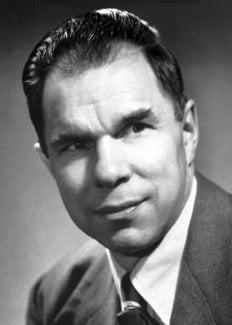Glenn T. Seaborg
Biographical

Glenn Theodore Seaborg was born in Ishpeming, Michigan, on April 19, 1912. At the age of 10 he moved with his family to California, in 1929 he graduated at David Starr Jordan High School in Los Angeles as valedictorian of his class.
He entered the University of California, Los Angeles, in 1929, and received the degree of Ph.D. in Chemistry from the University of California, Berkeley, in 1937. From 1937 to 1939 he was the personal laboratory assistant of the late G. N. Lewis, with whom he published a number of scientific papers. In 1939, Dr. Seaborg was appointed an instructor in chemistry at the University of California, Berkeley, where he was promoted to Assistant Professor in 1941, and to Professor of Chemistry in 1945. In 1946, he also took responsibility for direction of nuclear chemical research at the Lawrence Radiation Laboratory, operated for the Atomic Energy Commission by the University of California; from 1954 to 1961, he was Associate Director of LRL. In the same year, he was appointed by President Truman to be a member of the AEC’s first General Advisory Committee, a post he held until 1950. In 1958, he was appointed Chancellor of the University of California at Berkeley. In that capacity he served until his appointment by President Kennedy to the Atomic Energy Commission in 1961, when he was designated Chairman of the Commission. His term of office expires in 1968. From 1959 to 1961, he was also a member of the President’s Science Advisory Committee. Dr. Seaborg was given a leave of absence from the University of California from 1942-1946, during which period he headed the plutonium work of the Manhattan Project at the University of Chicago Metallurgical Laboratory. He was co-discoverer of plutonium and all further transuranium elements through element 102.
In addition to the discovery of transuranium elements, Dr. Seaborg and his colleagues are responsible for the identification of more than 100 isotopes of elements throughout the Periodic Table. He is also author of the actinide concept of heavy element electronic structure. In this connection, Dr. Seaborg demonstrated that the heavy elements form a “transition” series of actinide elements in a manner analogous to the rare-earth series of lanthanide elements. The concept demonstrated how the heavy elements fit into the Periodic Table and thus demonstrated their relationships to the other elements.
The body of information assembled in Dr. Seaborg’s laboratory has made it possible to predict the radioactive characteristics of many isotopes of elements still to be found. Under Dr. Seaborg’s leadership, also, whole new bodies of methodology and instrumentation have been developed and have become a cornerstone of modern nuclear chemistry. Dr. Seaborg is the author of approximately 200 scientific papers, including a number of comprehensive reviews and compilations in scientific publications. He is also author and co-author of several books on chemistry and the elements.
Honours include: in 1947 named as one of America’s 10 outstanding young men by the U.S. Junior Chamber of Commerce; 1947 recipient of the American Chemical Society’s Award in Pure Chemistry; 1948 John Ericsson Gold Medal by the American Society of Swedish Engineers; 1948 Nichols Medal of the New York Section of the American Chemical Society; 1953 John Scott Award and Medal of the City of Philadelphia; 1957 Perkin Medal of the American Section of the Society of Chemical Industry; 1959 Atomic Energy Commission’s Enrico Fermi Award for his outstanding work in the field of nuclear chemistry and for his leadership in scientific and educational affairs; in 1962, named Swedish American of the Year by Vasa Order of America, Stockholm; 1963 Franklin Medal of the Franklin Institute, Philadelphia.
Dr. Seaborg is an Honorary Fellow of the Chemical Society of London and of the Royal Society of Edinburgh. He is a Fellow of the American Institute of Chemists, the New York Academy of Sciences, the California Academy of Sciences, the American Physical Society and the American Association for the Advancement of Science. He is a Member of the National Academy of Sciences, the American Academy of Arts and Sciences, the Royal Society of Arts of England, and the Royal Swedish Academy of Engineering Sciences.
Honorary degrees awarded to Dr. Seaborg include Doctor of Science degrees from the University of Denver, 1951; Gustavus Adolphus College, 1954; Northwestern University, 1954; University of Notre Dame, 1961; Ohio State University, 1961; Florida State University, 1961; University of Maryland, 1961; Temple University, 1962; Tulane University, 1962; Drexel Institute of Technology, 1962; Georgetown University, 1962; University of the State of New York, 1962; Mundelein College, 1963; and Trinity College, 1963; the degree of Doctor of Laws from the University of Michigan, 1958; and University of Massachusetts, 1963; the degree of Doctor of Humane Letters from Northern Michigan College, 1962; the degree of Doctor of Public Service from George Washington University, 1962; and the degree of Doctor of Public Administration from the University of Puget Sound, 1963.
In 1942, Dr. Seaborg married Helen L. Griggs, then secretary to the late Dr. Ernest O. Lawrence (Nobel Laureate for Physics 1939). They have six children: Peter (b. 1946), Lynne (b. 1947), David (b. 1949), Stephen (b. 1951), John Eric (b. 1954), and Dianne (b. 1959). His chief hobby is golf, but he also follows other sports with interest. From 1953-1958 he served as the University of California (Berkeley) Faculty Athletic Representative.
This autobiography/biography was written at the time of the award and first published in the book series Les Prix Nobel. It was later edited and republished in Nobel Lectures. To cite this document, always state the source as shown above.
Glenn T. Seaborg died on February 25, 1999.
Nobel Prizes and laureates
Six prizes were awarded for achievements that have conferred the greatest benefit to humankind. The 14 laureates' work and discoveries range from quantum tunnelling to promoting democratic rights.
See them all presented here.
